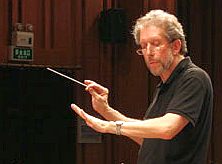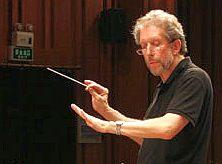Besides the fact that all three are dead, Maestro David Ramadanoff had one reason for putting Michael Daugherty’s Dead Elvis and Mozart’s Serenade in D major K. 239 (Serenata notturna) together with Beethoven’s Seventh Symphony on the Vallejo Symphony's Jan. 9 concert.
“The first half of the program really is an opportunity to feature a number of players from the orchestra as soloists,” he explained by phone.

Dead Elvis was intentionally written for the same colorful septet of instruments as Stravinsky’s A Soldier’s Tale because they share a common theme. Except in Daugherty’s piece, instead of Stravinsky’s soldier selling his soul to the Devil, Elvis sells his soul to Hollywood. The scenario clearly calls for principal bassoonist Karla Ekholm, who plays a number of jazzy, ironic, and funny variations on that classic tune of the celestial hit man, the Dies Irae.
“It’s fun, colorful, and very technically challenging for everyone who plays it because it’s so fast,” says Ramadanoff. It also demands lots of pyrotechnics from a bassoonist willing to try to look as well as play the part.
Like Daugherty, Mozart wrote his Serenata notturna as entertainment. But where Daugherty was trying to shock and entertain a concert audience, Mozart wished to entertain the royal court in Salzburg. Employing strings, timpani, and a slightly unusual solo string quartet of two violins, viola, and double bass, the piece might have left a smile on Elvis’ increasingly cynical face.
In addition to providing contrast with its full orchestra, Ramadanoff feels that Beethoven’s Symphony No. 7 in A Major fits the bill because of its liveliness. “All throughout the symphony,” he says, “Beethoven chooses certain figures that really push the music along. The scherzo is one of the fastest he ever wrote, and the final movement incredibly propulsive.”
Propulsion is certainly the name of the game for the orchestra’s players, most of whom are members of the “Freeway Philharmonic.” These musicians drive all over the place, playing their hearts out while doing their best to make ends meet. But what sets the Vallejo Symphony apart from the rest of the freeway pack, besides the fact that it is the seventh oldest orchestra in California, is the personal relationship between Ramadanoff and his players.
“I’ve known many of them since my days as conductor of the San Francisco Conservatory of Music Orchestra,” he says, “when they were either just graduating or first starting in the Freeway Philharmonic. We have a special chemistry. These folks know each other very well, and the small combo we’re using in the first half really likes working together and with me. We all feel we’re making good music together.”
The Vallejo Symphony performs in Hogan Auditorium, 850 Rosewood Ave. (corner of Georgia St.) in Vallejo on Saturday, January 9 at 8:00 p.m. For tickets, call 707-643-4441.

